On-chain Analysis Week 6 / 2025: Changing Perspectives - The Transformation In Bitcoin Investment
The regulatory environment for Bitcoin is constantly evolving, while financial products such as derivatives and ETFs are reshaping the market. This article examines the changing demographics of digital asset investors and what it means for the future of cryptocurrency investing.
2/11/20258 min read
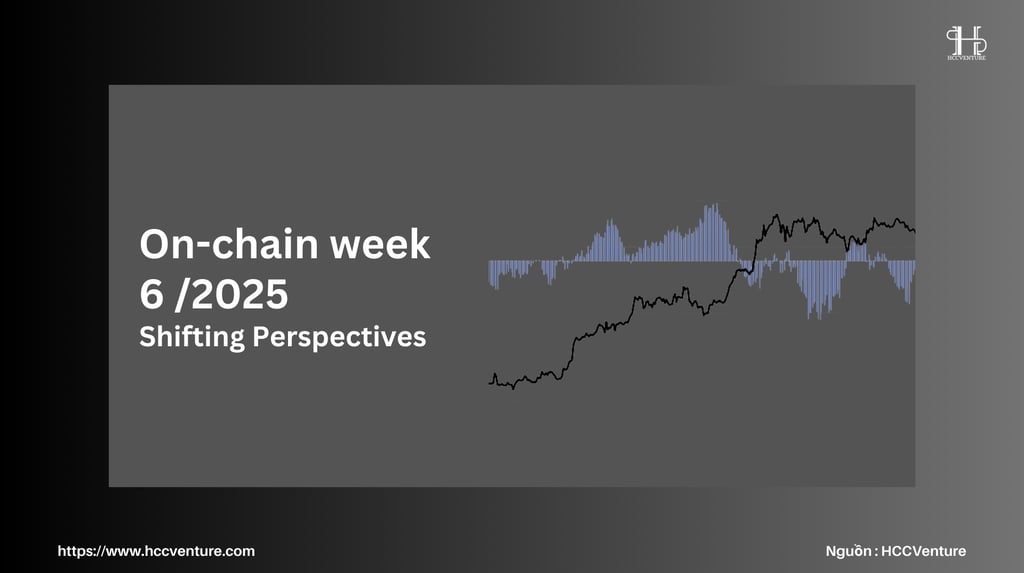

Summary
Bitcoin has evolved into a global financial asset with high liquidity and the ability to trade 24/7 , allowing investors to participate in the market even when traditional financial markets are closed. This offers significant advantages, especially in the context of macroeconomic volatility and changes in global monetary policy.
Currently, Bitcoin is consolidating its role as a store of value , with cumulative net inflows exceeding $850 billion . Additionally, Bitcoin also functions as a decentralized payment system , with an average daily transaction value of $8.9 billion , reflecting its growing market acceptance.
On-chain data shows that new demand for Bitcoin remains high, but has not reached the scale seen at the peaks of previous cycles. For example, the current Realized Cap growth rate is 2.1x , down from 5.7x in the previous cycle, suggesting that there is still room for expansion if capital continues to flow in.
One notable point is that the investor structure in the Bitcoin market is changing significantly. The ownership ratio of institutional investors and investment funds has increased significantly , leading to a narrowing of the price adjustment range and a gradual decrease in market volatility . This reflects the maturity of Bitcoin as a financial asset capable of attracting long-term capital flows, instead of being a purely speculative asset as in previous cycles.
On-chain metrics analysis

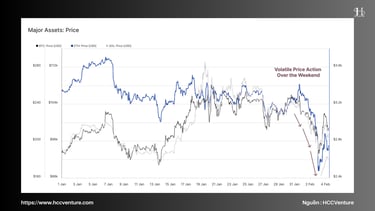
Since its inception in 2009, Bitcoin has evolved into a highly liquid global financial asset that allows for 24/7 trading . This makes Bitcoin one of the few assets where investors can react immediately to important economic and political events, even when traditional financial markets are closed.
Bitcoin and the cryptocurrency market saw a sharp correction over the weekend as investors reacted to the Trump administration’s decision to impose tariffs on Mexico, Canada, and China . With traditional markets like stocks and forex closed, Bitcoin and other digital assets became instantaneous reflections of macroeconomic volatility. Price Performance Across Major Assets:
Bitcoin (BTC): Dropped from $104,000 to $93,000 ( -10.5% ), then recovered to $102,000 .
Ethereum (ETH): Dropped from $3,400 to $2,500 ( -26.5% ), then recovered to $2,800 .
Solana (SOL): Dropped from $236 to $184 ( -22.0% ), then recovered to $217 .
The sudden drop, followed by a rapid recovery, reflects the high volatility of the cryptocurrency market in the face of economic shocks. It also highlights Bitcoin’s role as a macro-risk-responsive asset , while reinforcing the argument that cryptocurrencies are playing an increasingly important role in the global financial system.
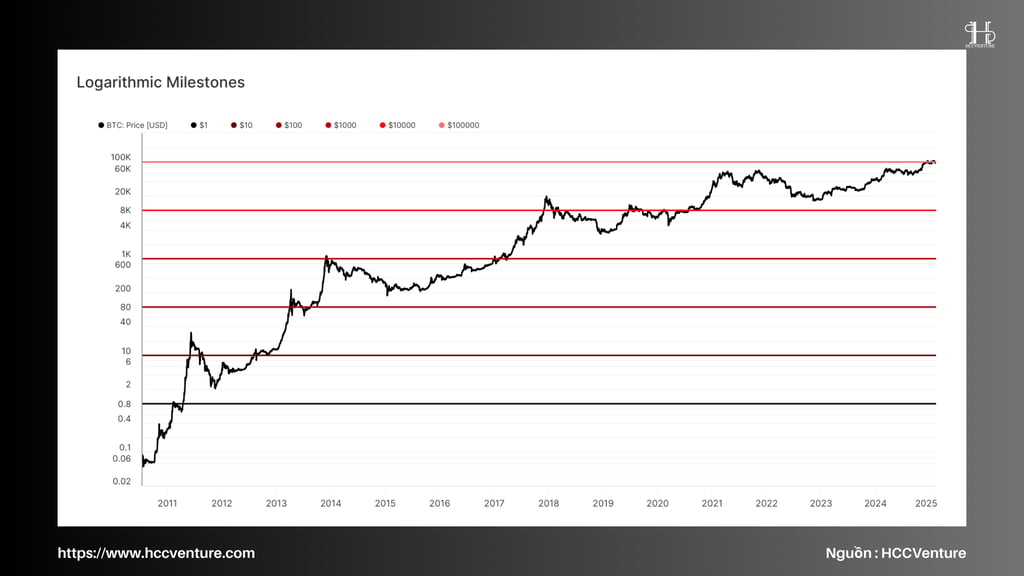

Bitcoin is increasingly asserting its important role on the international financial stage , as many countries begin to integrate Bitcoin into their economic and monetary strategies . Some typical examples include:
The Kingdom of Bhutan has launched large-scale Bitcoin mining operations , taking advantage of its abundant hydroelectric power resources.
El Salvador is the first country to recognize Bitcoin as legal currency , with the aim of attracting investment and boosting economic growth.
The US government is also evaluating Bitcoin's potential as a strategic reserve asset , similar to gold in the traditional financial system.
Bitcoin has now held above $100,000 for weeks , a milestone that many critics once said was unattainable . This marks a huge jump in value , as Bitcoin reaches this psychologically important milestone exactly seven years after surpassing $10,000 during the 2017 bull run.
This event not only demonstrates Bitcoin's exponential growth , but also reflects the traditional financial markets' growing acceptance of Bitcoin as a long-term store of value .
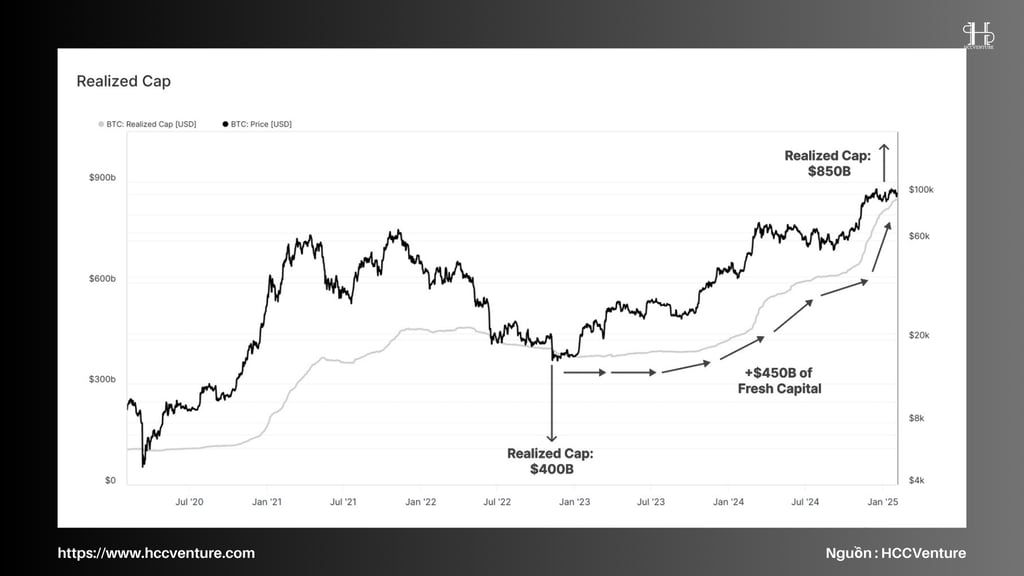

As an asset’s capitalization and weightings reach a large scale, market inertia increases , meaning that Bitcoin needs significantly more new capital to sustain its growth momentum. To gauge Bitcoin’s capital absorption, we can use the Realized Cap metric , which measures the total net capital inflows into the market.
If we take the comparison point from the cycle bottom in November 2022 , when Realized Cap was at $400 billion , then up to now, Bitcoin has attracted about +$450 billion in new capital flows , which means more than doubling the Realized Cap value in just over two years.
This reflects the total value stored in Bitcoin at around $850 billion , with each BTC valued at the last price it traded on-chain. This is a clear demonstration of Bitcoin’s growing acceptance as a store of value, and underscores that Bitcoin will need more investment inflows in order to continue expanding its capitalization in the future.
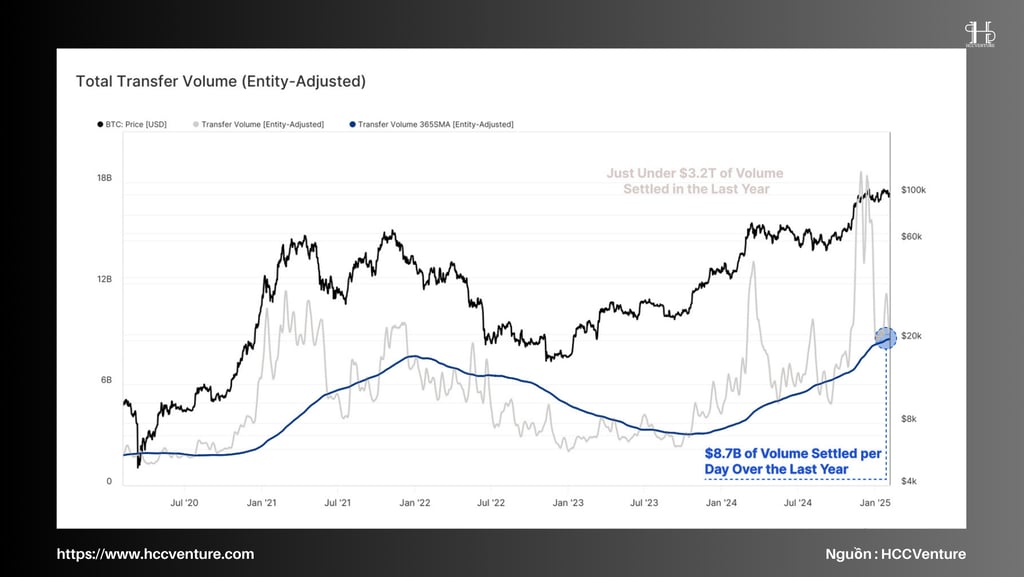

Although Bitcoin (BTC) is often viewed primarily as an emerging store of value, the Bitcoin network can also function as a decentralized system for remittances and payments, with BTC acting as a medium of exchange. The combination of nodes and miners allows any individual or organization to make cross-border payments without the intervention of a third party.
Using the entity-adjustment heuristic to filter out economically significant transactions, over the past 365 days, the Bitcoin network has processed an average of $8.7 billion per day , with the total value transferred over the past year reaching $3.2 trillion .
Both Realized Cap and the economic transaction volume processed over the Bitcoin network provide empirical evidence that Bitcoin has not only “value” but also “usefulness ,” refuting critics’ claims that Bitcoin has neither. The growth in transaction value on the network also demonstrates Bitcoin’s ability to play an important role as a global means of payment, with great potential to replace or supplement traditional payment methods.


Having identified the rise in importance of Bitcoin as a macro asset, we can turn our attention to analyzing its dominance relative to the broader Digital Asset ecosystem.
Since the FTX crash in November 2022, Bitcoin Dominance has maintained a steady upward trend, from 38% to 59%. This shows that there has been a shift in value and money flows focused on Bitcoin, with priority given to other digital assets.
Part of the reason may be that spot ETFs in the US have opened up greater access to institutional capital. Bitcoin also has a strong narrative as a scarce asset, viewed by many investors as a hedge against the devaluation of global fiat currencies. The growing belief in Bitcoin as a safe store of value is cementing its dominance in the digital asset ecosystem.
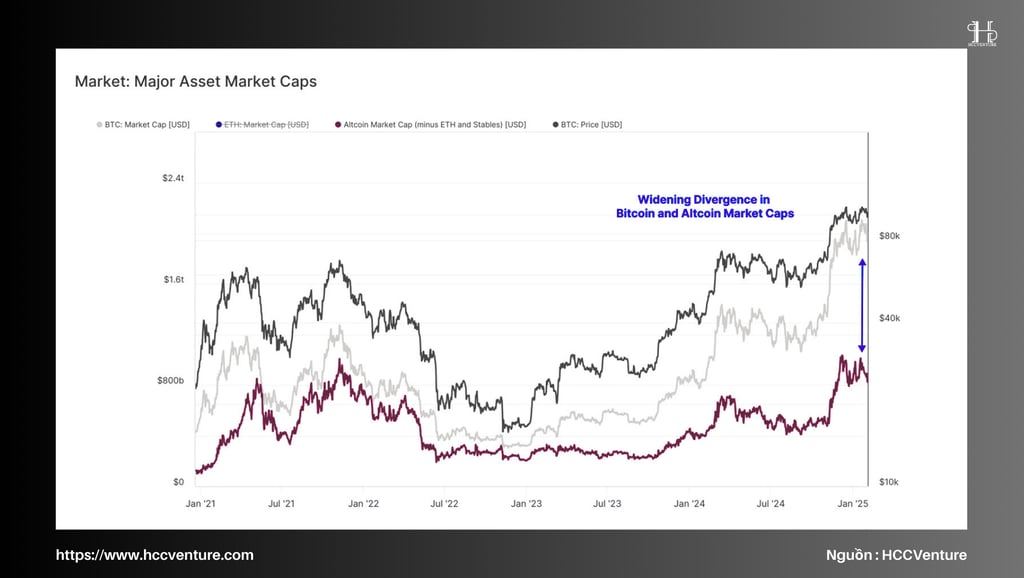

When comparing the Market Cap of Bitcoin and altcoins (excluding Ethereum and Stablecoins), we can see an increasing gap in valuation between them.
If we go back to the 2022 low , we can compare the growth of market capitalizations as follows:
Bitcoin Capitalization : From $363 billion to $1.93 trillion (5.3 times increase).
Altcoin Capitalization : From $190 billion to $892 billion (4.7 times increase).
While both groups have seen strong growth, Bitcoin’s rise has been stronger and more dominant, indicating a growing shift into Bitcoin. This disparity reflects a shift in investor sentiment, with Bitcoin increasingly taking the lead in the digital asset ecosystem.

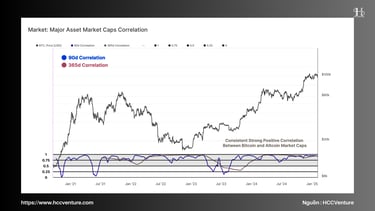
Despite the divergence in valuation scales between Bitcoin and altcoins , the correlation between the two assets remains very strong. This suggests that the main cause of this divergence is not the growth rates between the two groups, but rather the significant difference in capital flows into Bitcoin compared to altcoins .
Bitcoin continues to attract the majority of capital from investors, and so we can expect Bitcoin dominance to continue to increase. Meanwhile, if Bitcoin dominance starts to decrease, it will signal a rotation of capital from Bitcoin to other altcoins.
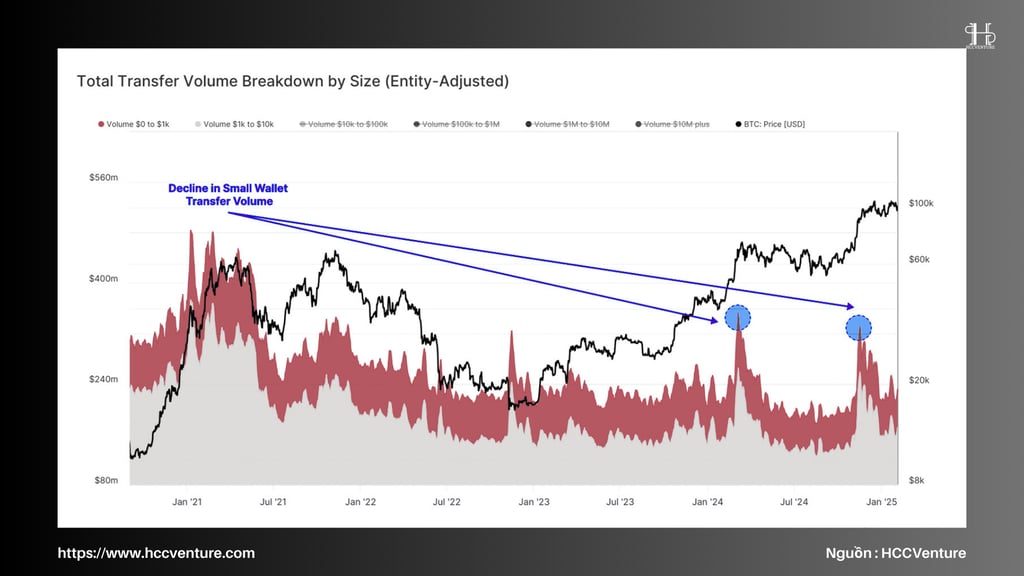

If we isolate the transaction volume from small wallets (under $10k), we can see a clear decline compared to the 2021 all-time high (ATH). This is despite the fact that the total transaction volume in the current cycle has increased significantly and the Bitcoin price is also much higher.
This suggests that new demand for Bitcoin is coming mainly from large institutions and large-cap investors, rather than retail investors.
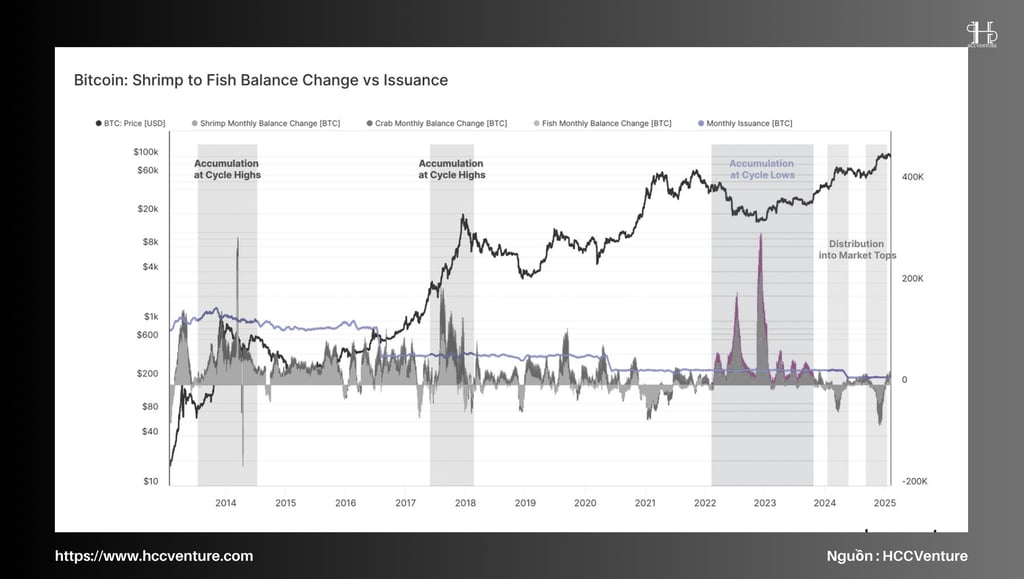

While the Bitcoin protocol is largely fixed in its structure and consensus code, the market’s response to it is a constantly evolving and changing process. The regulatory environment is constantly changing, and new financial instruments such as derivatives and ETFs continue to develop around Bitcoin. As the environment around Bitcoin changes, so does the makeup of Bitcoin investors, which is especially evident in the current cycle.
When comparing the change in balances of smaller entities (Shrimp-Crab, those holding <10 BTC), we notice a distinct change in behavioral patterns in recent years.
During the bull runs in 2013 and 2017, we could identify periods of strong coin accumulation from these groups, often accompanied by ‘buying at the top’ during the euphoria. However, this pattern seems to have changed in the current cycle, with smaller entities engaging in more aggressive accumulation during corrections and declines, and then switching to distribution as the market reaches new highs.
This shows the emergence of a more sophisticated and informed group of investors, even among those traditionally considered retail investors.
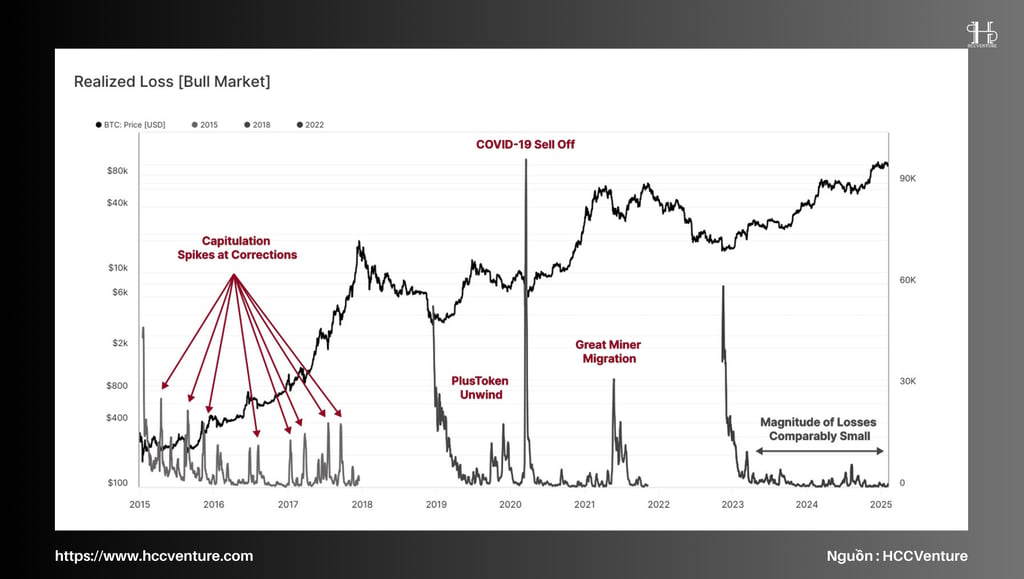

One of the great advantages of on-chain data is that it helps us map out investor behavior during stressful periods, such as during corrections and price declines.
When we look at the magnitude of losses made during bull markets, the current Bitcoin cycle remains the most conservative. The only notable event where Bitcoin investors recorded large losses was the yen-carry exit event on August 5. Apart from this event, the magnitude of losses has remained relatively small, indicating a patient, resilient group of investors who are less affected by price volatility.
This is a marked difference from previous cycles, where the 2015-2018 cycle was characterized by multiple localized capitulation episodes. The 2019-2022 cycle is even more volatile, with multiple deep and severe capitulation events, such as the PlusToken liquidation in mid-2019, the COVID-19 sell-off in March 2020, and the massive miner exodus in mid-2021.
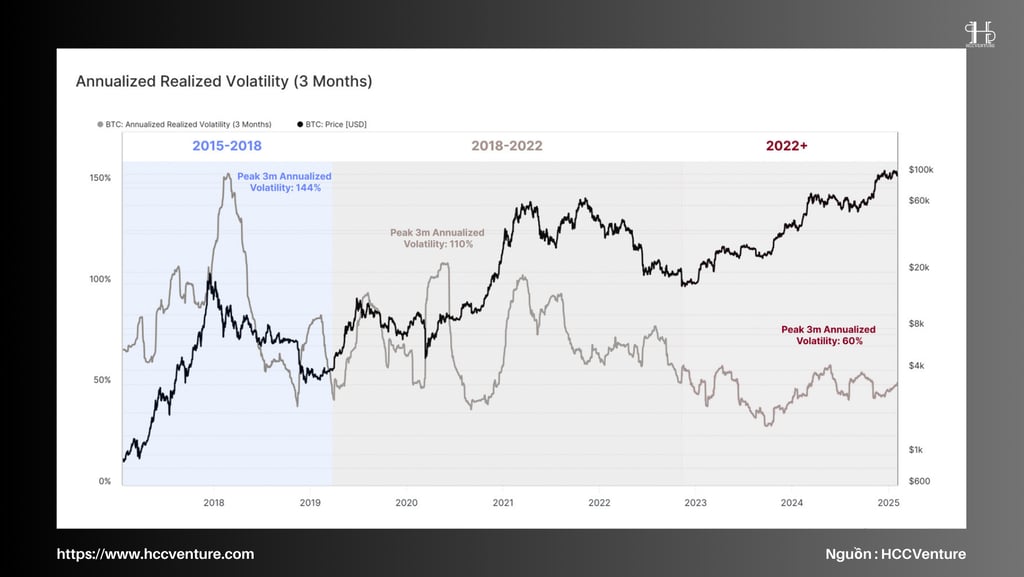

Bitcoin’s volatility is also in a state of flux, with realized volatility currently trading at record lows for a bull market. Realized volatility over the past three months has consistently remained below 50% this cycle, while in previous bull cycles it regularly exceeded 80% to 100%.
This suggests increased market stability, reflecting a change in investor behavior that is less reactive to short-term fluctuations. While previous cycles may have seen sharp sell-offs and sharp price swings, the current cycle appears to represent a more mature and patient investor base.
Evaluation and Conclusion
Bitcoin continues to assert its position as a global macro asset. Its availability to trade at any time of the day allows investors to express their market views, while its deep liquidity allows them to execute large-volume trades.
In response to criticisms of Bitcoin’s role as a store of value and a means of payment, the Bitcoin network has attracted over $850 billion in net capital, while processing nearly $9 billion in economic volume per day. This data largely disproves these claims.
Recent regulatory changes in the digital asset ecosystem have spurred an evolution in the investor mix, leading to the rise of sophisticated institutional investors in the Bitcoin market. This class of investors, which is more patient, resilient, and less price sensitive, has helped to reduce the magnitude of price drops and reduce volatility over time.
Join the HCCVenture community to get the latest market information. Once again, we give our opinion on potential projects in the crypto market. This is not investment advice, consider your portfolio. Disclaimer: The views expressed in this article are solely those of the author and do not represent the platform in any way. This article is not intended to be a guide to making investment decisions.
API & Data : Glassnode
Compiled and analyzed by HCCVenture
Join our telegram community: HCCVenture
Explore HCCVenture group
HCCVenture © 2023. All rights reserved.


Connect with us
Popular content
Contact to us
E-mail : holdcoincventure_contact@hccventure.com
Register : https://linktr.ee/holdcoincventure
Disclaimer: The information on this website is for informational purposes only and should not be considered investment advice. We are not responsible for any risks or losses arising from investment decisions based on the content here.


TERMS AND CONDITIONS • CUSTOMER PROTECTION POLICY
ANALYTICAL AND NEWS CONTENT IS COMPILED AND PROVIDED BY EXPERTS IN THE FIELD OF DIGITAL FINANCE AND BLOCKCHAIN BELONGING TO HCCVENTURE ORGANIZATION, INCLUDING OWNERSHIP OF THE CONTENT.
RESPONSIBLE FOR MANAGING ALL CONTENT AND ANALYSIS: HCCVENTURE FOUNDER - TRUONG MINH HUY
Read warnings about scams and phishing emails — REPORT A PROBLEM WITH OUR SITE.
